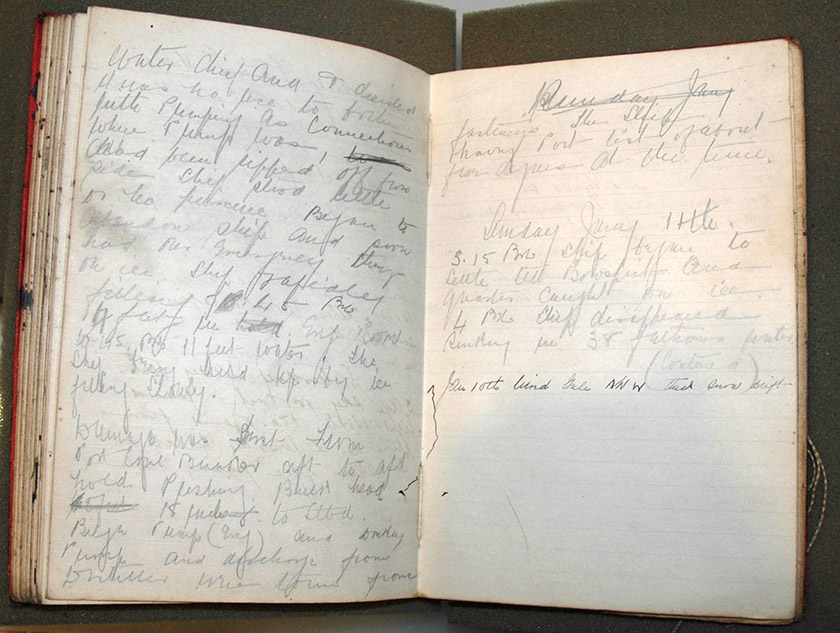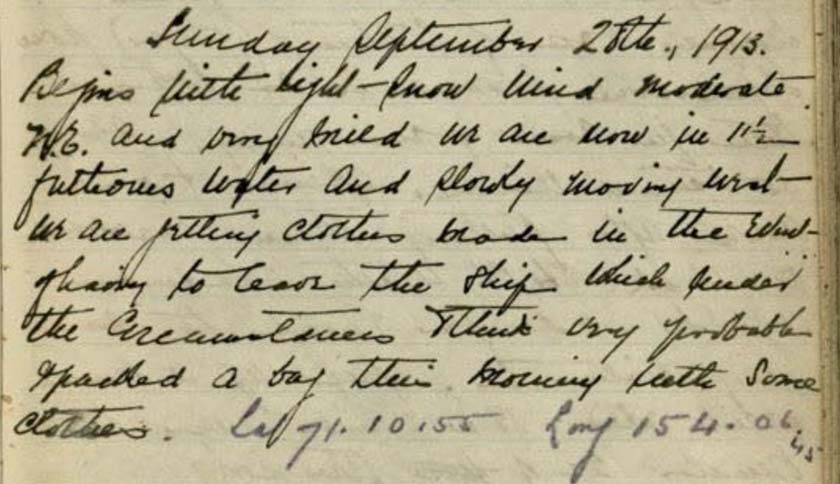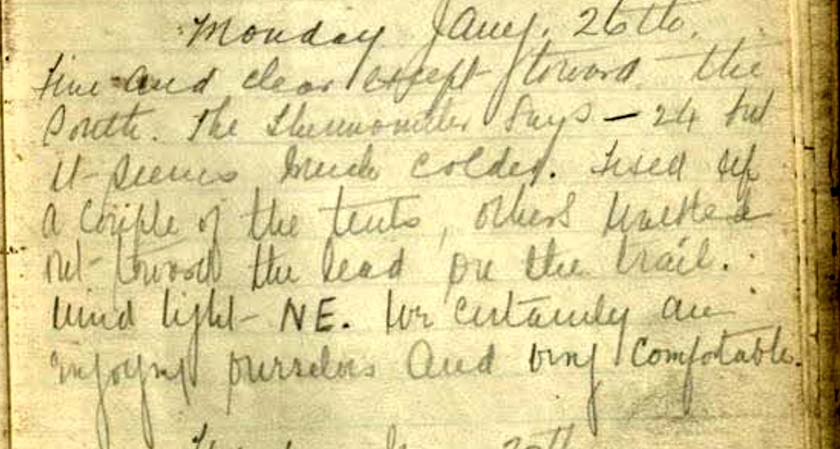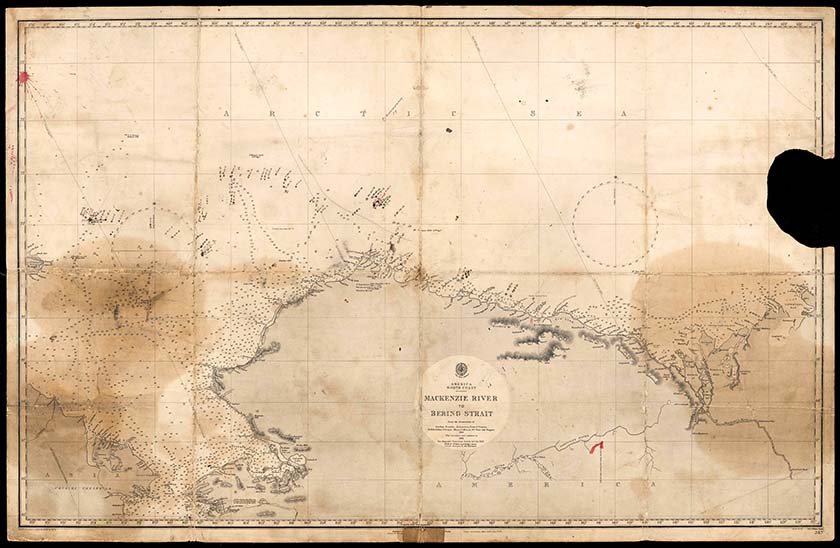Transcribing Historical Documents – Captain Robert Bartlett’s Journal from the Karluk
By Molly Schwanz
Bartlett’s journal, open to the entry for January 11th, 1914, the day the Karluksank. This journal was donated to the Peary-MacMillan Arctic Museum by Thomas Hale.
The process of transcribing an historical document involves creating a typed document that is as faithful as possible to the original written text. Transcribing documents such as Bartlett’s journal is important because it provides improved access to these important historical records. Transcriptions increase readability and can even be used to make documents searchable, allowing researchers to more easily find the information in which they are interested.
Transcribing a document requires learning to read another writer’s handwriting. Depending on the document’s author, this task can range from simple to rather difficult. Bartlett’s handwriting is somewhat challenging to decipher. The more time you spend with a person’s handwriting, the easier it is to read. Each writer’s script has different unique features; once you learn them, the process of transcribing becomes easier.
Below is an image of Bartlett’s journal entry for September 28th, 1913, as well as its transcription.

Sunday, September 28th., 1913.
Begins with light snow wind moderate N.E. and very mild We are now in 11 ½ fathoms water and slowly moving west We are getting clothes made in the event that we have to leave the ship which under the circumstances I think very probable I packed a bag this morning with some clothes. Lat. 71.10.55 Long 154.06.45
In this entry, you can see some of the characteristic elements of Bartlett’s handwriting. Particularly notable in this entry is the way Bartlett writes the letter E, which looks like a reversed number 3. Other distinct characteristics of Bartlett’s handwriting include tall ascenders on the letter P, and the word “I” being placed very close to the word beside it, sometimes making them appear as one word, visible in this sample were Bartlett writes “I packed a bag this morning.”
Bartlett’s handwriting changes somewhat throughout the journal, likely reflecting the challenging circumstances under which it was written. For example, the majority of the entries written after the Karluk sank on January 11th, 1914 are written in what appears to be pencil – earlier entries were written in ink. Here is a sample of Bartlett’s writing from later in the journal, showing his entry for January 26th:

Monday Jany. 26th.
Fine and clear except toward the south. The thermometer says -24 but it seems much colder. Fixed up a couple of the tents, others walked out toward the lead on the trail. Wind light NE. We certainly are enjoying ourselves and very comfortable.Compared to the entry from September 28th, the handwriting in this entry is larger, and has a less uniform slant.
Sometimes a document can’t be read perfectly, requiring the transcriber to decide how best to convey the document’s contents to future readers. How do you transcribe a word that you’re not sure you’ve read correctly, or can’t read all together? Typically, a question mark in brackets - [?] - is included after words that the transcriber is unsure about, and [illegible] is used where a word cannot be read. Another annotation that you may see in a transcription is [sic]. This is used to indicate that the transcriber has copied something exactly as the original author wrote it. Commonly, [sic] is used where the author has used an alternate or incorrect spelling, but it can be used in other circumstances as well.
Punctuation can present another challenge to transcribers. For example, Bartlett occasionally omitted punctuation at the end of his sentences. In order to increase readability, when transcribing I used a double space to indicate a break between sentences where no punctuation had been used.
The content of Bartlett’s journal is largely devoted to practical matters such as recording the ship’s location, the temperature and weather, and the condition of the ice, as well as preparations being taken in case it became necessary to abandon ship, and later, preparations for the trek to Wrangel Island. However, some entries do provide glimpses into life aboard the Karluk. On December 25th, Bartlett describes the crew’s Christmas celebrations, which featured several athletic contests and a dinner which included oyster soup, lobster, green peas, and strawberries, among other delicacies. Other entries record Bartlett’s own thoughts. On February 14th, Bartlett writes of his concern for Ernest Chafe, who had left on February 7th, carrying supplies ahead in preparation for the journey to Wrangel Island:
I am watchman tonight and I spent sometime over the chart. The bearing[?] and distance would make it Herald Island and then again the soundings do not agree with the chart. I am quiet[sic] anxious till Chafe comes back. Read Omar Khayyam tonight I have read it a good deal lately and it never appears to get tiresome
Chafe returned to camp two days later on February 16th.

I found it very moving to engage so closely with a document that was being written while the events it describes were occurring, and all the more tragic to know that not everyone whose name appears in Bartlett’s journal survived the voyage. Two names which appear often are those of Bjarne Mamen and George Malloch. Both men’s names are frequently connected to hunting expeditions and trips to ferry supplies to caches along the trail to Wrangel Island. Malloch also carried out many of the astronomical observations that were necessary for determining the Karluk’s position. In his entry of December 15th, Bartlett writes of Malloch: “Mallock[sic] is a wonder he keeps working all the time for stars and transits.” Sadly, both Mamen and Malloch died on Wrangel Island. Theirs were not the only lives lost during the expedition. Of the 31 who had been aboard the Karluk when she became frozen in the ice, 20 survived.
Several of the Karkluk’s survivors published accounts of their experiences, including Bartlett who, along with Ralph Hale, wrote The Last Voyage of the Karluk, published in 1916. If you are interested in learning more about the story of the Karluk, I also recommend The Ice Master: The Doomed 1913 Voyage of the Karluk, by Jennifer Niven, which is a very readable account of the voyage and its aftermath.
I am glad to have had the opportunity to transcribe this journal. It is not often that we have the chance to read the thoughts of an historical figure, not only in their own words, but as written in their own hand. I hope that this transcription will prove helpful to future researchers who would like to learn more about Captain Robert Bartlett and the Karluk’s final voyage.